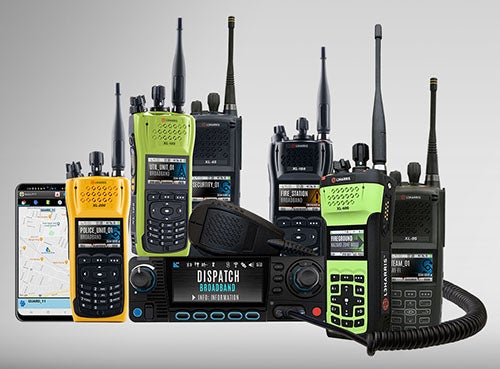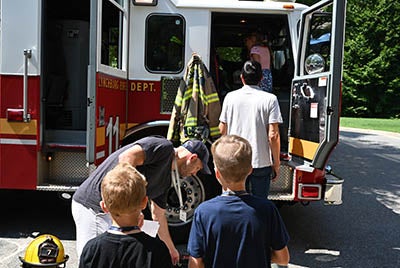Designed and built to deliver communications capabilities in user-friendly form factors at feasible price points, L3Harris devices are trusted by public safety agencies across the Commonwealth of Virginia to keep lives safe.
“We are a technology innovator; we listen to problems customers have, and we customize and design mission-critical communications solutions to meet those challenges, and we have great relationships,” Wayne Duff, L3Harris Account Management lead, said, noting L3Harris currently provides radio systems for more than 25 counties in the state. “Our footprint and presence in Virginia is a result of that.”
The first L3Harris P25 Phase 2 system ever deployed was in Pittsylvania County, Virginia, in 2011. This event was a significant catalyst for the company, moving public safety technology forward and proliferating P25 Phase 2 trunked systems worldwide, according to Duff.
The key to success in this program, he said, was always remaining engaged with the customer and on top of any issues. Additionally, L3Harris worked with the county to ensure optimal coverage and remain within the allocated budget.
“The great thing is our systems are expandable,” Duff said. “We recently added three new tower sites to increase the county’s coverage footprint. L3Harris is very flexible, and we work extremely well with our customer to meet and exceed their expectations.”
The number of L3Harris customers in Virginia is partly a result of the success in this program, Duff notes.
L3Harris was also the first to market converged Land Mobile Radio (LMR) and LTE networks on the same device. As an emerging technology, not all customers have a full grasp of the advantages converged radio networks can provide to their agencies, according to L3Harris senior Account Management specialist Chuck Spruill. Regardless, the “extremely competitive price point” combined with the potential need for these advanced capabilities have made the XL Converge™ 200P an intriguing option for agencies, public works and school districts in the Commonwealth.
In addition to Push-To-Talk over cellular and WiFi as well as PTT over LMR on the same device, converged networks offer enhanced in-building coverage and cost savings. Since most schools, government buildings and hospitals have WiFi already installed, tower requirements can be reduced while still providing critical, expanded coverage.
“L3Harris is able to provide enhanced in-building coverage by utilizing existing WiFi networks at no extra charge,” he added. “Even if a customer isn’t ready for LMR/LTE convergence, they already have the capability with our products.”

A Passion for Personnel Safety
“I used a very reliable mission-critical communication system that saved my life many times – more so than any weapon,” Duff, a former Lynchburg, VA, Deputy Chief of Police with over 20 years of service, said, noting the city used L3Harris products his entire career. “When we pushed the button for help, it worked. When I came here, I found out many public safety professionals didn’t experience that level of great coverage and reliable mission-critical communications.”
Spruill served the Sheriff’s Office of Campbell County, VA for eight years, with another seven as a Magistrate for the County. During this period, Spruill didn’t use L3Harris radios. The terrain in the southern end of the county made it so “you just knew [your radio] wasn’t going to work,” he said.
Today, in areas of insufficient radio frequency coverage, public safety officers often have to rely on cellular coverage. However, there was no cellular service back in the 1980’s, so when the radio system didn’t work, officers were on their own, according to Spruill.
“When I was in a tight situation as a police officer and I was able to summon help, by pushing my emergency button or Push-To-Talk button, and you start hearing everybody ‘mark in route,’ that might deescalate a situation,” Duff said.
After learning that there were more law enforcement officials who had been in Spruill’s shoes, it became Duff’s “passion” to ensure as many public safety officials as possible never again called out for assistance only to hear static on the other end.
Marching through the Old Dominion State
Back in 2011, L3Harris provided radio systems for three public safety customers out of 95 counties in the entire state.
“Part of our ‘Win Virginia’ campaign strategy was to ensure we retained those three customers while expanding across the state, focusing first on the agencies that were in dire need of critical communications upgrades or replacements,” Duff said. “It started with capitalizing on relationships we had. We’ve built lasting partnerships and have the most Project 25 Phase 2 trunked technology in the Commonwealth.”
Having served as law enforcement officers, Duff and Spruill can directly relate to the challenges facing public safety.
“We’ve been able to deliver L3Harris technology, developed and fielded by the U.S. Department of Defense, to those serving our communities. Duff said. “Every new customer with an open mind to change awarded a contract to us. Often public safety officials will borrow radios from neighboring jurisdictions to be able to communicate. We’ve eliminated this by providing our customers with multiband radios that can talk on any system regardless of the radio frequency band.”

Building Success by Bridging Communities
Several L3Harris systems in Virginia began with one county but quickly included neighboring communities—increasing both cost savings and opportunities for cross- agency collaboration.
For example, the jurisdictions in Region 2000 have always worked well together, according to Duff; they even have a formal regional crime investigation team that collaborates on major crimes.
For this program, L3Harris focused on the region as a whole with a goal to maximize coverage for the entire area, rather than looking for siloed solutions for each individual county. This led to a design that includes three simulcast cells – in the north, south and central – maximizing the coverage footprint for the entire region.
L3Harris provides interoperable and converged technologies that deliver a “clean solution” to connect disparate networks.
“If a county wants to stand up a system, we can bring in their neighbors to share the cost of infrastructure and maintenance and reduce their total cost of ownership,” Duff said, “and we can continue to connect more systems, providing the best coverage and seamless interoperability.”
What began as a stand-alone system in King and Queen County was expanded to include Essex, Richmond and Matthews counties within six years, with Northumberland and Lancaster counties soon to follow.
“It takes great agency partnerships that cross jurisdictional boundaries for regional systems to work,” Duff said. “The Upper Middle Peninsular Regional Radio System (UMPRRS) began with a vision to design, develop and deploy a the best public safety regional communications system available in the market. This regional system includes Radio Frequency sites that serve multiple counties, which reduces cost.”
Investing in Local Communities
“We’re very involved in the local community,” Duff said. “We’re vested in the communities in which we work, and we’ve grown such great relationships. I’m very proud of what we’ve done in Virginia.”
L3Harris views community involvement as much more than simply selling a radio system, according to Duff; the company provides services to the communities because the company and 1,500 employees working in the state are part of them.
